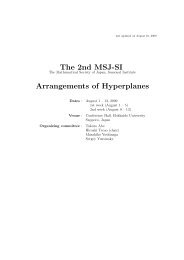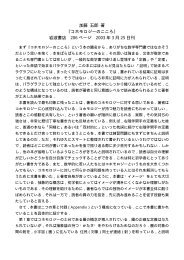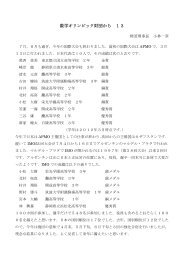Titles and Short Summaries of the Talks
Titles and Short Summaries of the Talks
Titles and Short Summaries of the Talks
You also want an ePaper? Increase the reach of your titles
YUMPU automatically turns print PDFs into web optimized ePapers that Google loves.
8 Foundation <strong>of</strong> Ma<strong>the</strong>matics <strong>and</strong> History <strong>of</strong> Ma<strong>the</strong>matics<br />
9:30–11:40<br />
March 21st (Thu) Conference Room VII<br />
Final: 2013/2/7<br />
13 Kohtaro Tadaki (Chuo Univ.) ♯ The generic group model <strong>and</strong> algorithmic r<strong>and</strong>omness · · · · · · · · · · · · · · 20<br />
Summary: In modern cryptography, <strong>the</strong> generic group model is used as an imaginary framework<br />
in which <strong>the</strong> security <strong>of</strong> a cryptographic scheme is discussed. In particular, <strong>the</strong> generic group<br />
model is <strong>of</strong>ten used to discuss <strong>the</strong> computational hardness <strong>of</strong> problems, such as <strong>the</strong> discrete<br />
logarithm problem, which is used as a computational hardness assumption to prove <strong>the</strong> security <strong>of</strong> a<br />
cryptographic scheme. In this talk, we apply <strong>the</strong> concepts <strong>and</strong> methods <strong>of</strong> algorithmic r<strong>and</strong>omness<br />
to <strong>the</strong> generic group model, <strong>and</strong> consider <strong>the</strong> secure instantiation <strong>of</strong> <strong>the</strong> generic group, i.e., a<br />
r<strong>and</strong>om encoding <strong>of</strong> <strong>the</strong> group elements. We show that <strong>the</strong> generic group can be instantiated by<br />
a specific computable function while keeping <strong>the</strong> computational hardness originally proved in <strong>the</strong><br />
generic group model.<br />
14 Kenshi Miyabe (Kyoto Univ.) ♯ Van Lambalgen’s Theorem for uniform Kurtz r<strong>and</strong>omness · · · · · · · · · · · 15<br />
Summary: The <strong>the</strong>ory <strong>of</strong> algorithmic r<strong>and</strong>omness defines some r<strong>and</strong>omness notions such as<br />
Martin–Löf r<strong>and</strong>omness, Schnorr r<strong>and</strong>omness, Kurtz r<strong>and</strong>omness, Demuth r<strong>and</strong>omness <strong>and</strong> so<br />
forth. Van Lambalgen’s <strong>the</strong>orem is one <strong>of</strong> <strong>the</strong> most important <strong>the</strong>orems in <strong>the</strong> <strong>the</strong>ory <strong>of</strong> algorithmic<br />
r<strong>and</strong>omness <strong>and</strong> talks about relative Martin–Löf r<strong>and</strong>omness. The usual relativization works well<br />
for Martin–Löf r<strong>and</strong>omness (thus, van Lambalgen’s <strong>the</strong>orem holds), but it does not work well for<br />
o<strong>the</strong>r r<strong>and</strong>omness notions. In my previous work, I proposed uniform relativization <strong>and</strong> proved<br />
van Lambalgen’s <strong>the</strong>orem for uniform Schnorr r<strong>and</strong>omness. In this talk, I will talk about van<br />
Lambalgen’s <strong>the</strong>orem for uniform Kurtz r<strong>and</strong>omness.<br />
15 Akitoshi Kawamura (Univ. <strong>of</strong> Tokyo) ♯ On representations <strong>of</strong> analytic functions <strong>and</strong> polynomial-time com-<br />
Norbert Müller (Univ. Trier) putability <strong>of</strong> operators · · · · · · · · · · · · · · · · · · · · · · · · · · · · · · · · · · · · · · · · · · 15<br />
Carsten Rösnick (TU Darmstadt)<br />
Martin Ziegler (TU Darmstadt)<br />
Summary: We study <strong>the</strong> computational complexity <strong>of</strong> operators on analytic functions. We work<br />
in <strong>the</strong> framework <strong>of</strong> Recursive Analysis, <strong>the</strong> <strong>the</strong>ory <strong>of</strong> real computation by approximation up to<br />
guaranteed error bounds. We introduce <strong>and</strong> compare several representations <strong>of</strong> analytic functions.<br />
We <strong>the</strong>n study <strong>the</strong> polynomial-time computability <strong>of</strong> basic operators on analytic functions, <strong>and</strong><br />
discuss extensions to larger classes <strong>of</strong> smooth functions.<br />
16 Takayuki Kihara (JAIST) ♯ An application <strong>of</strong> Kumabe–Slaman forcing to <strong>the</strong> ω-decomposability<br />
problem on Borel functions · · · · · · · · · · · · · · · · · · · · · · · · · · · · · · · · · · · · · · 20<br />
Summary: We show some variants <strong>of</strong> <strong>the</strong> Jayne–Rogers Theorem at finite <strong>and</strong> transfinite levels <strong>of</strong><br />
<strong>the</strong> hierarchy <strong>of</strong> Borel functions, by using <strong>the</strong> Shore–Slaman Join Theorem on <strong>the</strong> Turing degrees.<br />
This can be viewed as a partial solution to Andretta’s conjecture <strong>and</strong> Motto Ros’ conjecture on <strong>the</strong><br />
strong generalizations <strong>of</strong> <strong>the</strong> Jayne–Rogers Theorem.<br />
17 Tatsuya Miyazaki (Nagoya Univ.) ♯ On rigid Souslin trees <strong>and</strong> <strong>the</strong>ir preservation · · · · · · · · · · · · · · · · · · · · · · 15<br />
Summary: The author investigated <strong>the</strong> rigid structure <strong>of</strong> Souslin trees. A rigidity notion “free”,<br />
for Souslin trees, is known to be preserved under forcings with <strong>the</strong> property (K). This can be used to<br />
obtain <strong>the</strong> consistency result that <strong>the</strong>re is a rigid Souslin tree <strong>and</strong> simultaneously <strong>the</strong> CH fails. The<br />
author introduces a new rigidity notion for ω1-trees <strong>and</strong> proves an analogous preservation result.<br />
The investigation includes a few structural analysis for various rigid Souslin trees.

















